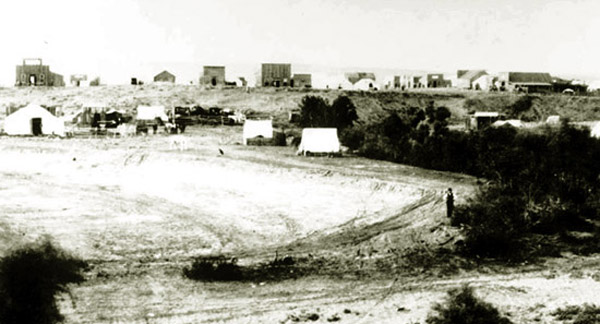
Cheyenne, 1867, looking toward 16th Street at top of hill.
Cheyenne was laid out by
Gen. Dodge as a division point before the Railroad began its climb westward over the
Gang Plank and the summit at Sherman Station. And like many end of tracks towns, it was
an overnight wonder, a tent city in which the residents would do business and move on the
the next end of tracks city. Such was the town's first mayor, H. M. Hook, an owner of the
Great Western Corral on the corner of O'Neal and 20th Streets. Hook had come from
LaPorte, Colorado, a stage station soon bypassed as a result of the railroad. Previously,
Hook had been the stage station manager at Dogtown, Nebraska, an adobe establishment, nine miles east
of Fort Kearney. Shortly after his installation as mayor, Hook again moved westward to Green River
City. Green River, itself, almost faded from existence when Bryan was made the division point. Allegedly,
Hook drowned while attempting to navigate the Green River on a raft on a prospecting
expedition.
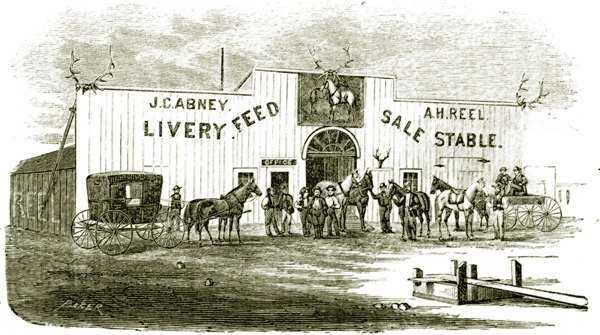
James C. Abney and Alexander H. Reel's Elkhorn Livery Barn, corner of
18th and Reed, Cheyenne, 1868
The above depicted livery barn later burned and was replaced by a brick livery depicted on a later page. James Clay "J. C." Abney (1837-1899) with Alexander "Heck" Reel (1837-1900)
both moved to Denver from
Nebraska City and established a livery stable in Denver. With the coming of the railroad to Cheyenne, they moved the
livery operation to Cheyenne. Abney had been on his own from about the age of 12 and had been a range rider. Reel, had been a freighter, running frreight from
Nebraska City to Salt Lake City by way of Denver. Abney was elected to the first territorial legilature and was the
first legislator to speak and vote for women's sufferage. Reel later served in the legislature both in the House and the Senate. He also served as
major of Cheyenne. Reel's sister, also as later discussed was the first woman in the United States elected to a state-wide office. In Cheyenne, Reel ran freight for
the Army to Fort Fetterman. He later purchased the Spur Ranch in Lincoln County where he died in 1900. Abney had several postal contracts with the United States. During the
last two years of his life, he served as a Justice of the Peace.
Others who followed the tracks westward from Nebraska City to Cheyenne included gunsmiths Franz Wilhelm "Frank" Freund (1837-1910)
and his brother George Freund who came in 1867 after short
sojourns in end of the tracks towns North Platte and Julesburg. Auctioneer Jonathan R. "J. R." Sumner arrived the same year from
Colorado. The Freund Brothers established their gunsmithery in the Whitehead Building on Eddy Street. The Whitehead building was the first
permanent building constructed in Cheyenne. On the same street, Sumner established his
commission and auction business.
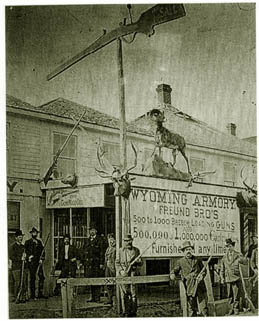 . . . . . .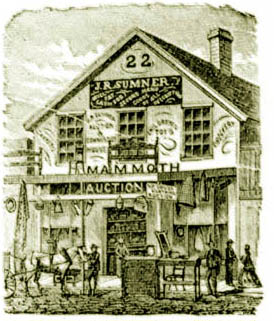
Left, Freund Bro.'s gunshop, Whitehead Building, Eddy Street, undated; Right, J. R. Sumner's
Commission and Auction House, Eddy Street, 1868
The Freund Brothers continued moving west opening temporary gunshops at "end of the tracks" towns including
Dale City, Laramie, Benton, Green River, Bear River City, South Pass City, Corrine and Salt Lake City. They also opened a
shop in Denver on Blake Street. The Laramie store had a little more permancy. The brothrs each held various patents for
improvements to Sharp's rifles and made a few of their own carbines, the "Wyoming Saddle Rifle." They, however, maintained a continuing presence in Cheyenne until the brothers split up in
1880 when George moved to the next "hot" spot, Durango, Colorado, where he died in 1911. In 1885, Frank moved to Jersey City where he died in 1910.
J. R. Sumner remained in Cheyenne for less than two years and then moved westward. By 1870 he was in the San Francisco Bay area. He later lived in
Oakland and Berkley. For a brief time in 1880 he was in Bodie.
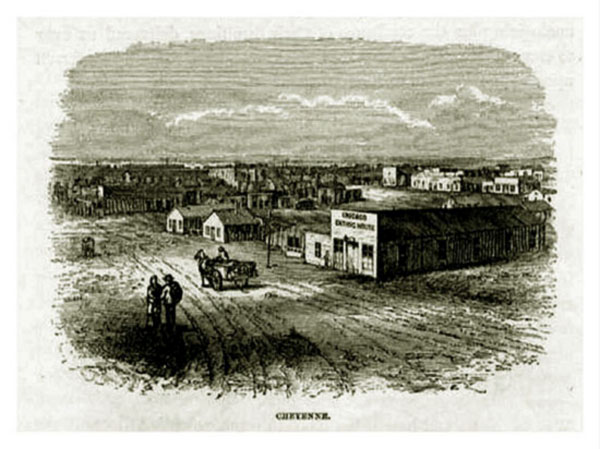
Cheyenne, 1868
The first lots sold for $150.00 each. Within a month, lots were selling for $1,000.00 each and increasing
monthly during the first summer. The first settlers were J. R. Whitehead, A. C. Beckwith, Thomas E. McLeland, later a city councilman and
postmaster, and Robert M. Beers. As depicted at the top of the page, the first houses were either tents or houses constructed of
lumber brought in from Colorado. The first tent was put up by A. C. Beckwith and the first permanent structure was constructed by
Whitehead (photo of Freund Brothers "Wyoming Armory" above). The Whitehead Building was razed in 1927.
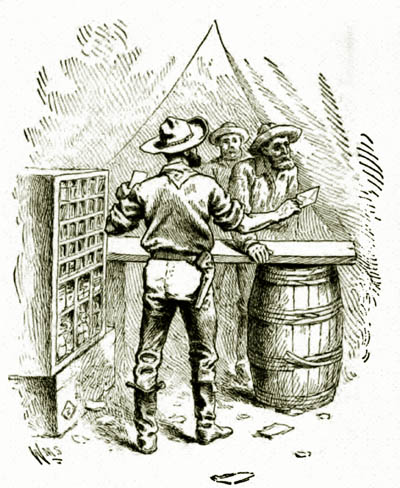 Interior Cheyenne Post Office, 1867 Interior Cheyenne Post Office, 1867
John W. Clampitt in his 1889 account Echoes From the Rocky Mountains described Cheyenne upon its founding:
As the day advanced we beheld in the far distance what appeared
to be a speck upon the horizon. As we approached, it assumed the
aspect of the white wings of motionless animals. They were the
white tents of the embryo city of Cheyenne—mere dots upon the vast
plain. They were the advance-guard of the army which shortly
appeared and laid the foundation of the capital city of the new Territory
of Wyoming. At that time there were not more than a dozen tents,
and yet the "new city" wore an aspect of business. Wells, Fargo &
Company had located upon a prominent corner, another tent covered
the United States post office, a third was a newspaper office, while the
others served as stores, saloons and places of commercial resort, not to
forget that of the justice of the peace, whose jurisdiction was boundless
amid the wilds of this Western civilization. He would hear and decide a
case in equity or on the law side of the court with as much composure
and firmness of purpose as if he was sitting and presiding as Chief
Justice of the Supreme Court of the Territory.
* * * *
The taste of those wedded to refinement in all things would have been
seriously shocked, by a glimpse at the internal arrangement of the Cheyenne
post office at that early day. I frequently visited it subsequently,
when it was sumptously furnished, when the town of phenomenal growth had attainted, within six months, a population
of 10,000, and the postmaster rejoiced in a salary of $3,000 per annum.
But at the period of which I speak, the office was a little wall tent and
the furniture a deal-box split in two, one half resting upon the upturned end of a second
box of like character, and partitioned off in pigeon holes of a rude
structure with the refuse lumber of the boken box.
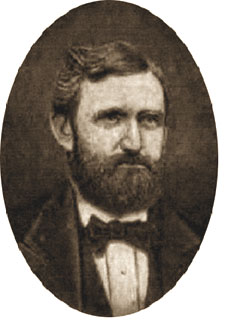 John Wesley Iliff John Wesley Iliff
With the arrival of the Union Pacific on November 13, 1867, Denver merchant, John Wesley Iliff,
received a contract from the Railroad to provide beef for the railroad crews. He
established a cow camp five miles down Crow Creek from Cheyenne. In town his place of business for wholesale and retail
sale of beef was on the south side of 17th Street. Thus, the town became a terminus of the Goodnight-Loving
Cattle Trail from Texas. Charles Goodnight drove cattle for Iliff up the Trail. The City literally, unlike Rome, was built in
a day. Thus, early promoters
portrayed the city as the "Miracle City of the Plains." None the less as a result of its end-of-the-trail status, it became known as the "Holy City of the Cow."
Crow Creek became a source of water for irrigation and the City's reservoirs. Thus, today as one
views the Creek in its full magnificence, one is reminded of the suggestion, attributed to Mark Twain as
to another mighty Western water course, that it should not be left out at night, lest a stray dog should
lap it all up. For more on Crow Creek and the City's reservoirs, see Silver Crown Mining District.
The Trail ran from northwest of San Antonio, crossed the
Pecos at Horsehead Crossing and then ran into New Mexico. From
there it followed the Pecos until the trail turned north into
Colorado passing near present day Deer Trail.
In the first year, Goodnight sold Iliff $40,000 worth of cattle and during
the period up to 1876 provided some 30,000 head of longhorn.
In 1867, the two partners trailed two herds of cattle from Texas to Fort Sumner, New Mexico Territory.
The trail crossed the ninety mile wide waterless Llano Estacado, the staked plain, so-called because
early Spanish explorers had to stake their trail in order to find their way across. After reaching Horsehead Crossing,
Loving rode ahead with one of his drovers, Jim
Scott. Along the Pecos near present-day Loving, New Mexico, the two were attacked by Comanches. Loving's
mule was shot from beneath him. In the fall, one of Loving's legs was shattered. The two hid along the
bank of the river. Ultimately it became necessary for Jim to attempt to walk back for help. For two days and nights,
Jim made his way back toward the herd, He passed out with fatigue. He was found by his brother, a drover with Goodnight's herd.
In the meantime, Loving dispared of being found and attempted to crawl for help dragging his shattered leg. He passed out but was
found by a Mexican freighter on his way from Fort Sumner to Fort Stockton.
"Que vienen, hombres! Que vienen por el amor de Dios! Aqui esta un
muerto." But Loving was not dead.
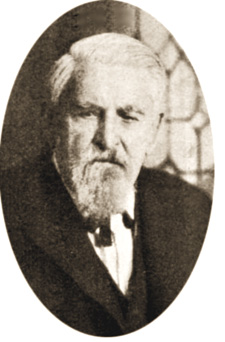
Charles Goodnight.
Shortly, Goodnight's and his men arrived. In a nine day's forced march,
Loving was carried in a crude Mexican wagon to Fort Sumner. Gangrene began to set in. But there was no
surgeon at the Fort. Loving's life could be saved only by amputation of the leg. The Fort hay and wood contractor, Scot Moore, rode the 130 miles through
Navajo infested territory to Las Vegas east of Sante Fe. Even today, U.S. Highway 84, which follows the route, is
a long, lonely deserted highway. A surgeon was obtained in Las Vegas and the two rode back to Fort Sumner. Moore covered 260 miles in
30 hours. But Loving was too weak and not withstanding the amputation died. His last wish was to be buried in
Texas. Goodnight dutifully carried his partner's body back 600 miles to
Texas from New Mexico in a buckboard. Because of the hot New Mexico sun, it was
necessary that the casket be filled with charcoal and sealed with flattened tins.
Goodnight is also noted for being the inventor of the chuckwagon.
In 1866 he bought a war surplus Studebaker army wagon, added a canvas cover, water barrel, tool box and nailed a
set of kitchen cabinets to the back. Studebakers were especially suitable since they
used steel axles and could take the rough ride over the trails. Eventually similar wagons were sold by
Studebaker Brothers for $75 to $100.
Historian, Dee Brown, has attributed the popularization of the term "cowboy"
to Goodnight's wife, Mollie, who referred to her husband's drovers as their "boys." The term, howver,
dates back to a least the American Revolution when it was used to describe Loyalist
rustlers in the Mid-Hudson Valley of New York. The most famous was Claudius
Smith who had a hideout in the Ramapo Mountains and would raid farms in Orange,
and Rockland Counties, New York and Bergen County, New Jersey. He was eventually captured and
hanged on January 22, 1779, at Goshen, New York. Rustlers who preyed on Loyalist farmers were known as "skinners."
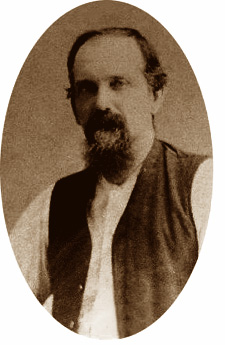 Clay Allison, 1885
One of Goodnight's "boys" who helped lay out the Goodnight Trail was the
infamous self-styled "shootist" Robert Clay Allison. Allison after leaving Goodnight's employment, started
his own ranch in New Mexico in 1870. He could best be described as a belligerent drunk. The Confederate Surgeon
General's Department, in giving him an administrative discharge for medical reasons, described him as:
"incapable of performing the duties of a soldier because of a blow received
many years ago. Emotional or physical excitement produces
paroxysmals of a mixed character, partly epileptic and partly maniacal."
Allison reputedly killed 15 men. However, his reputation was initially made as a result of
his involvement in the lynching of Charles Kennedy. Kennedy, at the instigation of Allison, was
dragged out of a jail in New Mexico, taken to a local slaughter house and dispatched. He was
then decapitated by Allison, who impalled Kennedy's head on a pole, and carried it to Henry Lambert's
Saloon on the Cimarron for display. In another incident in Canadian, Texas,
Allison allegedly strode around town seeking a gunfight, clad only in boots, hat and
gunbelt with two revolvers. In Las Animas, Colo., Allison killed a deputy sheriff. Two other deputies
fled town. As a result of his reputation Allison found it increasingly difficult to
find a town where he was welcome to sell his cattle.
In 1886, Allison trailed a herd of cattle to Rock Creek. Suffering from a tooth ache, he
stopped off in Cheyenne on his return to New Mexico and sought out the services of a dentist. The dentist,
unfortunately, began drilling the wrong tooth. Allison left the dentist and had the
tooth corrected by another dentist. He then returned. Pinning the first dentist in his chair, Allison
commenced the forcible extraction of the dentist's teeth. Only the response of passersby to the screams
emitting from the dental office saved the dentist.
That, however, was not the only time that Allison visited Cheyenne. Allegedly, Allison was involved in a fight with
local residents of Dodge City. Shortly thereafter three men bushwhacked Allison outside of town. He survived by playing dead. He
recognized the three. When Allison recovered from his wounds and reappeared on the streets, the three deemed it
expedient to get out of Dodge. Allison was one not to forgive slights and proceeded over the next months
to track his assailants down. He found the first in Cheyenne. His assailant got off the first shot, but it
went wild. Allison's shot did not. The second assailant was found in Crook County along the
Belle Fourche and the third in Tombstone.
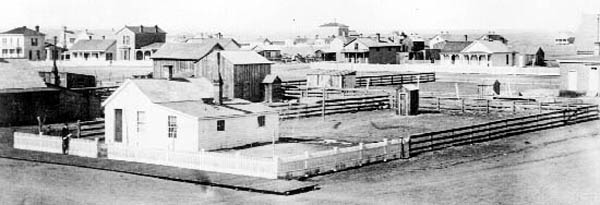
Cheyenne, 1876
Next page, Cheyenne Photos continued, Cheyenne 1868-69. |